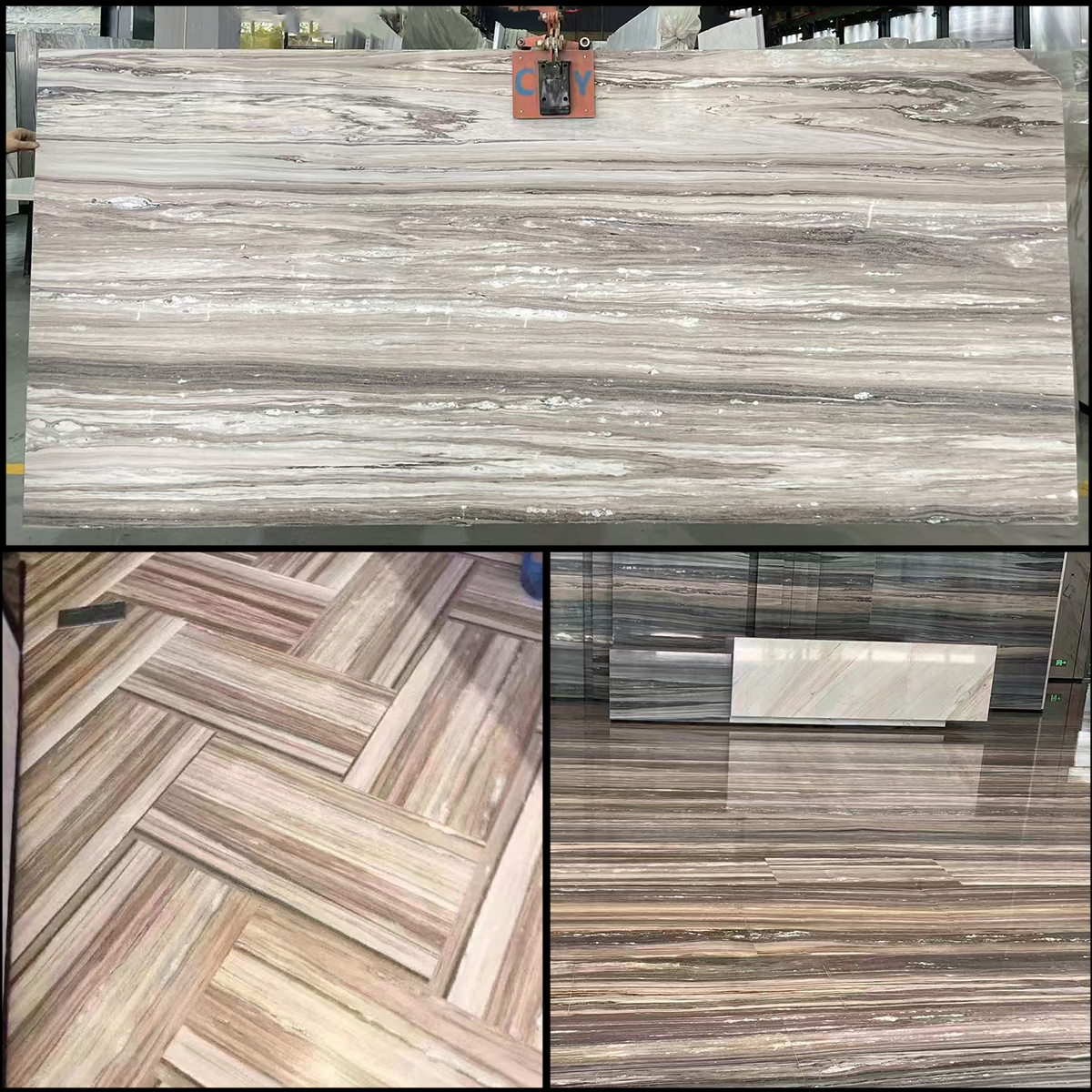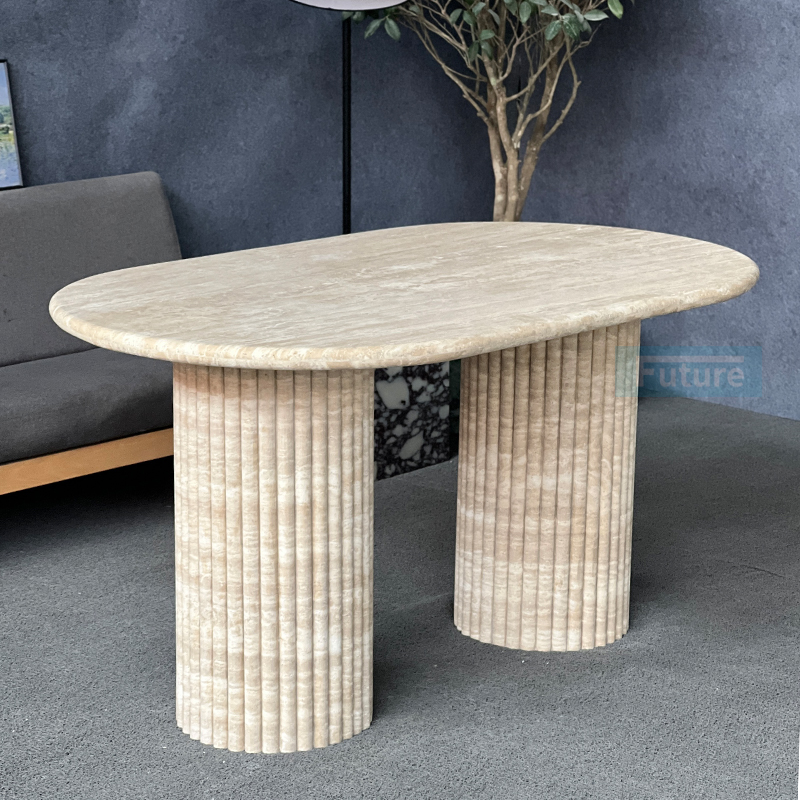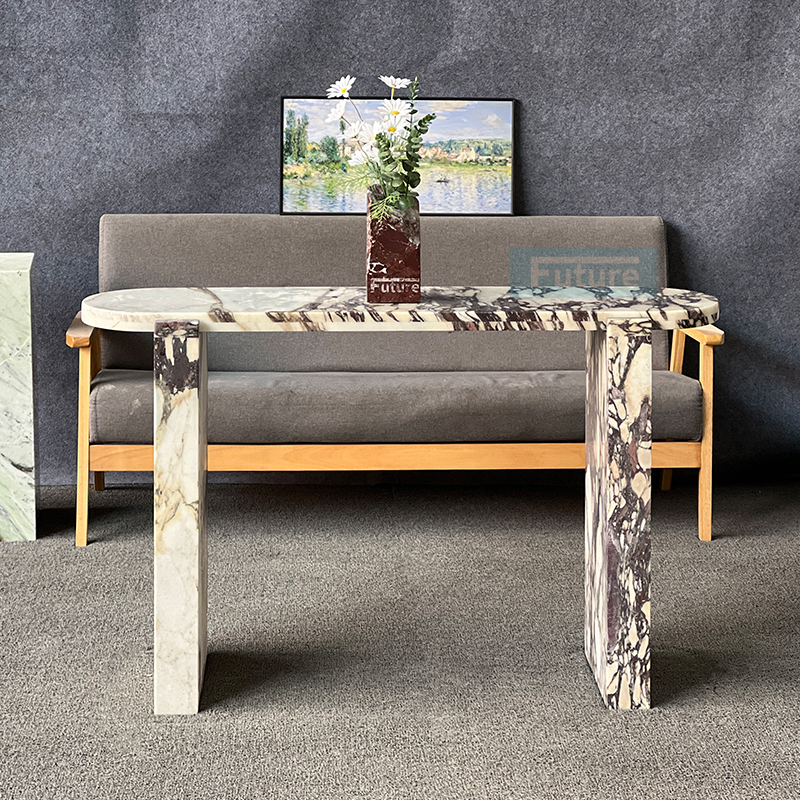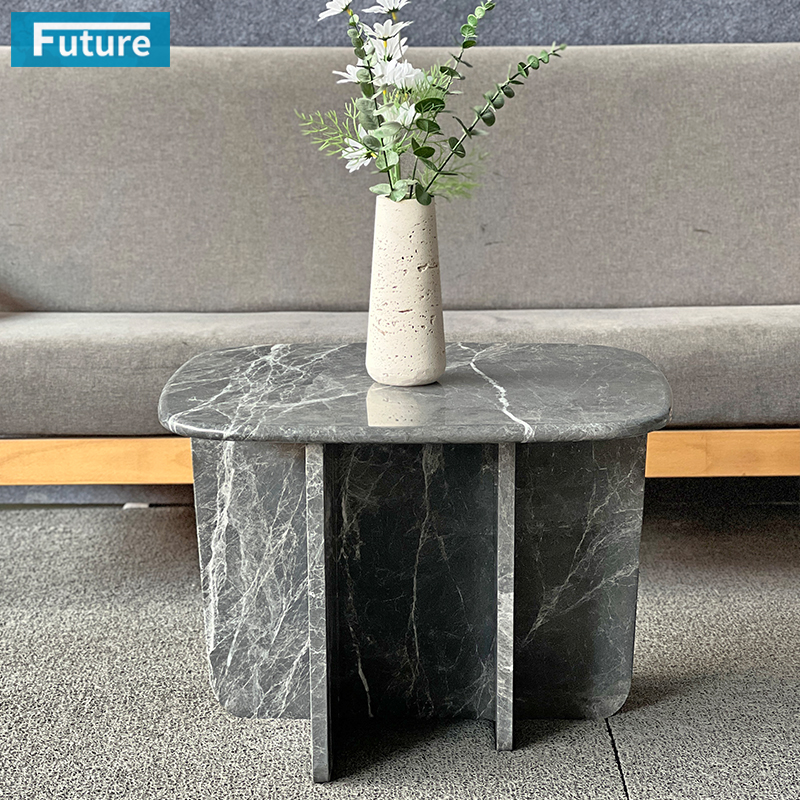For much of modern design history, marble has been specified primarily for countertops, floors, and feature walls—surfaces that frame a space rather than furnish it. In the last few years, however, architects and interior designers have begun treating marble as a structural, sculptural medium for furniture, using it for dining tables, coffee tables, consoles, side tables, and plinths that act as the visual and functional centerpieces of a room.
This shift is not a short‑lived trend but part of a broader return to authentic, long‑lasting materials and the desire for interiors anchored by a few remarkable objects instead of many disposable ones. For stakeholders in premium projects—from luxury residences to hospitality and boutique commercial spaces—understanding how to specify, engineer, and maintain marble furniture is now an essential part of contemporary stone practice.
From Surface To Furniture: How We Got Here
Several converging forces explain why marble has moved from background surface to foreground furniture.
Design‑wise, contemporary interiors favor calm, minimal shells enriched by a small number of strong focal elements; a marble dining table or low plinth coffee table delivers exactly that mix of restraint and drama. At the same time, advances in CNC fabrication, stone‑to‑metal joinery, and lightweight honeycomb panels make it practical to realise complex stone forms that were once too heavy or fragile for everyday furniture use.

On the client side, discerning homeowners and hospitality brands are seeking “quiet luxury”: genuine materials, tactile depth, and pieces that will still look relevant in twenty years. Marble, with its unique veining and enduring cultural association with craftsmanship and architecture, fits this brief more convincingly than most synthetic alternatives.
Market Overview: Marble Furniture As A Growth Category
Dedicated research on the marble table segment confirms that this is now a substantial and expanding market, not an experimental niche. One global study projects the marble table market growing from the mid‑single‑digit billions of USD to significantly higher levels by 2033–2034, with compound annual growth rates in the $5%–$6% range driven by residential upgrades and commercial fit‑outs.
Parallel reports for the broader marble and granite market also highlight furniture and interior applications—beyond slabs and tiles—as one of the key demand drivers over the coming decade. Online search data underscores this reality: high‑intent keywords such as “marble table,” “marble coffee table,” and “marble dining table” consistently rank among the most commercially valuable search terms within the stone and furniture categories.
For a manufacturer like Future Stone Group, which already combines slab production, custom fabrication, and finished furniture, this creates a strategic opportunity to serve both project‑driven and retail channels with integrated stone solutions.
Why Marble Furniture Resonates With Designers
From an architectural standpoint, marble furniture offers three key advantages: visual authority, material authenticity, and system continuity.
- Visual authority: A well‑proportioned marble dining table, console, or plinth acts like a three‑dimensional sculpture, giving a space hierarchy and focus without relying on ornament.
- Material authenticity: In an era of digital finishes and printed laminates, the depth and unpredictability of natural veining read as honest and unrepeatable, which designers and end clients strongly value.
- System continuity: When the same stone appears across floors, walls, countertops, and furniture, the interior feels unified; the table looks “born” of the architecture rather than added as an afterthought.
These qualities explain why marble furniture is now common in high‑budget homes and hospitality projects, where it supports brand storytelling and positions the space firmly in the luxury tier.

Core Furniture Typologies In Marble
Dining tables
Marble dining tables have become signature pieces in villas, penthouses, and upscale restaurants, often specified as the primary focal element in open‑plan living and dining areas. Current design language favors:
- Monolithic or pedestal bases that appear carved from a single volume of stone.
- Soft rectangles, rounds, or organic “pebble” shapes instead of sharp‑cornered tops, improving circulation and comfort.
For larger spans, architects frequently combine stone with an internal steel or aluminum frame, allowing slender profiles without compromising stiffness or safety.
Coffee tables
In living spaces, marble coffee tables have evolved from simple rectangles to sculptural objects that anchor seating groups. Three prevalent directions are:
- Low plinth tables in expressive stones such as Calacatta Viola, green marbles, or deep blacks that read as “art pieces.”
- Mixed‑material tables pairing a marble top with slim metal or timber legs for visual lightness and cost efficiency.
- Clustered or nesting tables in different heights and diameters, sometimes combining multiple stone types for layered compositions.
Consoles, side tables, and plinths
Consoles and side tables are a natural entry point for marble furniture, especially in circulation areas, entrance halls, and bedrooms.
Slim marble consoles in a dramatic stone—paired with a mirror or artwork—create a high‑impact first impression in lobbies and corridors, even where floor and wall finishes are deliberately minimal. Side tables and bedside tables, often with solid cylindrical or block bases, provide functional surfaces while reinforcing the overall stone palette of the project.
Plinths and low blocks in marble, travertine, or onyx are increasingly used to display sculptures, vases, and lighting, turning accessories into curated vignettes. Future Stone Group’s dedicated categories for coffee tables, side tables and plinths, dining tables, and console tables reflect this typology‑based approach.
Material Choices: From Calacatta Viola To Travertine
A defining advantage of marble furniture is the range of expressions it can achieve simply through stone selection.
- High‑drama stones: Varieties such as Calacatta Viola, bold‑veined Calacatta types, intense greens, and Nero / Black Marquina are ideal for statement dining tables, coffee tables, and consoles that must hold their own against expansive glazing or large‑scale art.
- Refined neutrals: Soft whites, beiges, and warm greys—often seen in collections of Arabescato, Lincoln white, and other light marbles—support quiet luxury schemes, Scandinavian minimalism, or coastal interiors.
- Complementary stones: Travertine, terrazzo, and onyx bring additional texture and translucency; travertine furniture supports wabi‑sabi and Mediterranean aesthetics, while backlit onyx consoles and bar fronts provide dramatic focal points in hospitality projects.
Future Stone Group’s stone gallery spans marble, onyx, travertine, granite, quartz, terrazzo, and quartzite, allowing designers to build nuanced palettes that extend from surfaces into furniture.
Technical Engineering: What Professionals Must Consider
Structural behavior and slab selection
Unlike wall cladding, furniture pieces must perform under concentrated loads, dynamic use, and point impacts. Critical considerations include:
- Vein orientation and internal flaws: Slabs should be selected and cut so that the primary veining and any natural fissures are oriented to minimize risk of cracking under bending or impact.
- Thickness and span: Traditional solid marble tables often use thicknesses of $20–$30 mm for tops, but spans must be carefully checked; too thin over long unsupported distances increases deflection and the risk of breakage.
- Hidden reinforcement: Many premium pieces conceal metal frameworks or ribs under the stone, especially for large dining tables or reception desks; this is standard practice in high‑traffic hospitality and commercial environments.
Future Stone Group’s project division routinely integrates stone with metal subframes in complex elements such as staircases, reception desks, and furniture, which gives designers a single point of responsibility for performance.
Lightweight stone and honeycomb panels
Lightweight stone panels—thin stone bonded to aluminum honeycomb or similar cores—have transformed what is possible in stone furniture. Systems like DuraMet and comparable honeycomb solutions can bring the weight of a panel down to as low as roughly $18–$22.5 kg/m² at thicknesses in the $15–$25 mm range, while retaining stiffness and impact resistance.
For marble furniture this means:
- Large tables and cabinets become easier and safer to transport, install, and reconfigure.
- Vertical elements such as tall cabinets, shelving, and wall‑mounted consoles can be executed in genuine stone without excessive load on fixings or substrates.
- Edges and corners are engineered through mitered build‑ups and corner treatments so that the piece reads as solid stone from the user’s perspective.
Future Stone Group’s capability to work with both solid and lightweight constructions allows specifiers to balance visual intent, structural performance, and logistics on a project‑by‑project basis.
Surface Finishes, Protection, And Practical Maintenance
Marble furniture lives at the intersection of aesthetics and daily use, so finishes and protective strategies must be considered early in the design process.
- Polished: Enhances color and veining, gives a highly reflective, formal look, but makes etching from acids and micro‑scratches more visible.
- Honed: Matte or satin finishes reduce glare and conceal minor wear, making them popular for dining and coffee tables in busy homes and hospitality spaces.
- Textured / leathered: Subtle textures add grip and tactile richness; they work especially well on side tables and console tops where indirect light accentuates the surface.
Because marble is porous, regular sealing is essential to protect against oils, pigments, and organic staining agents. Industry guidance and leading furniture brands recommend:
- Gentle daily cleaning using pH‑neutral stone cleaners or mild soap and water, never harsh or acidic products.
- Immediate blotting (not rubbing) of spills like wine, coffee, citrus, and vinegar to minimize etching and staining.
- Resealing every 6–12 months depending on usage, finish, and stone porosity, confirmed with simple absorption tests (e.g., observing darkening after a few drops of water or oil).
Future Stone Group supports its furniture collections with maintenance recommendations and, where required, can pre‑treat pieces with professional sealers appropriate for the intended use and market.
Application Scenarios: Residential, Hospitality, And Commercial
Luxury residences
In luxury homes, marble furniture is often used to unify open‑plan interiors where the kitchen, dining, and living spaces visually flow into one another. A common strategy is to echo the kitchen island stone in the dining table, coffee table, and entrance console, creating a calm, continuous material story from arrival through to the main living area. Marble bedside tables, vanities, and plinths then carry the same language into bedroom and bathroom suites, reinforcing the project’s identity.

Future Stone Group’s stone furniture range and gallery of coordinated marble, onyx, travertine, and quartz slabs make this kind of whole‑house material choreography straightforward for architects and interior designers.
Hotels, resorts, and branded residences
In hospitality, marble furniture plays a dual role: it must handle high traffic while setting a strong, memorable tone aligned with the brand. Reception desks, lobby coffee tables, concierge consoles, and bar counters in expressive marble instantly communicate permanence and investment, which supports premium room rates and brand positioning.

Recent case studies from luxury hotels show that lobby and bar refurbishments centered on custom marble furniture can materially increase guest satisfaction scores, social media engagement, and event bookings by elevating the perceived quality of the space. Future Stone Group’s project experience across entrances, luxury lobbies, staircases, and furniture—combined with global shipping—allows hotel and resort designers to specify unified stone concepts from concept through installation.
Offices, galleries, and retail
In commercial environments, marble furniture is increasingly specified for reception counters, executive tables, gallery plinths, and boutique retail fixtures. These elements act as “architectural furniture,” bridging the gap between building and brand, and they benefit from the durability and reparability of stone in high‑touch zones.

For brands seeking a minimalist aesthetic, a single marble table or sales counter—well lit and carefully proportioned—can carry the entire visual narrative of luxury without the need for extensive decorative treatments.
Design Trends Shaping Marble Furniture In 2025
Industry reports and design studios highlight several clear tendencies in 2025 marble furniture.
- Warmer palettes: Beige, cream, soft brown, and ivory marbles are displacing cooler greys, aligning with a broader move toward warm minimalism.
- Jewel tones and blacks: Rich greens, deep blues, and striking blacks are used for high‑contrast tables and consoles that act as focal points in otherwise neutral rooms.
- Sculptural silhouettes: Curved edges, asymmetric tops, and chunky cylindrical or block bases give tables and plinths an artistic presence.
- Mixed materials: Brass, blackened steel, timber, and glass are combined with marble to balance warmth, texture, and visual lightness.
- Biophilic and wabi‑sabi influences: Travertine, textured finishes, and stones with pronounced natural variation support interiors that feel grounded and nature‑connected rather than overly polished.
Future Stone Group’s portfolio—including Calacatta‑type marbles, Black Marquina, warm neutrals, travertine, terrazzo, and onyx—maps directly onto these trends, enabling specifiers to design future‑proof collections.
Natural Marble, Engineered Stone, And Hybrid Strategies
While this article focuses on natural marble, many high‑performing projects pair marble furniture with engineered stones or sintered surfaces in adjacent applications. Engineered quartz and sintered stone excel in kitchen worktops and outdoor bars that face intensive chemical and thermal loads, while natural marble might be reserved for dining tables, coffee tables, and consoles where tactile quality and visual richness are paramount.
Future Stone Group manufactures both premium marble and engineered stone products, allowing architects and designers to orchestrate hybrid solutions from a single supplier, simplifying sample management, color matching, and logistics.
Specification Guidelines For Professionals
For architects, interior designers, and contractors, a robust marble furniture specification typically addresses:
- Use case and location: Residential vs. hospitality, indoor vs. covered outdoor, public vs. private zones.
- Stone selection: Color, veining intensity, porosity, and compatibility with adjacent finishes and lighting conditions.
- Construction method: Solid stone vs. stone‑on‑honeycomb, presence of metal framing, and disassembly requirements for transport and access.
- Finish and edge details: Polished, honed, or textured surfaces; eased, chamfered, or mitered edges for safety and durability.
- Protection and maintenance: Sealer specification, cleaning products, and simple care instructions to be included in handover documentation.
Future Stone Group’s technical team regularly collaborates with specifiers at concept and detailed‑design stages, providing stone recommendations, shop drawings, and mock‑ups for complex furniture and integrated stone packages.
How Future Stone Group Leads In Marble Furniture
Future Stone Group positions itself not only as a slab supplier but as a full‑cycle partner for premium stone furniture and architectural stonework. The company’s capabilities encompass material sourcing, a broad stone gallery, precision fabrication, and fully custom coffee tables, side tables, plinths, dining tables, consoles, vanities, and cabinets for international projects.
For high‑end developed markets, Future Stone Group focuses on premium marbles—including Calacatta‑type whites, Calacatta Viola‑style stones, and Black Marquina—paired with advanced fabrication and detailing suitable for luxury villas, hotels, and flagship commercial spaces. For rapidly growing markets, the company can combine statement marble pieces with value‑driven options in travertine, terrazzo, and engineered stone, ensuring that design intent and budget remain aligned.
Through its dedicated stone furniture line and experience in global shipping and project coordination, Future Stone Group offers architects, designers, and homeowners a reliable, expert partner for turning marble furniture concepts into enduring, buildable realities.
Conclusion: Beyond Surfaces, Toward Sculptural Living
The rise of marble furniture marks a significant evolution in how the design community understands and deploys stone. No longer confined to floors and countertops, marble now shapes the way people sit, dine, gather, and display the objects that matter to them, bringing architectural gravitas into the realm of everyday touch.
For professionals and clients committed to long‑lasting, material‑driven design, partnering with a specialist manufacturer like Future Stone Group—who can supply, engineer, and finish marble furniture to the highest standard—transforms stone from a background surface into the signature element of the entire interior experience.



